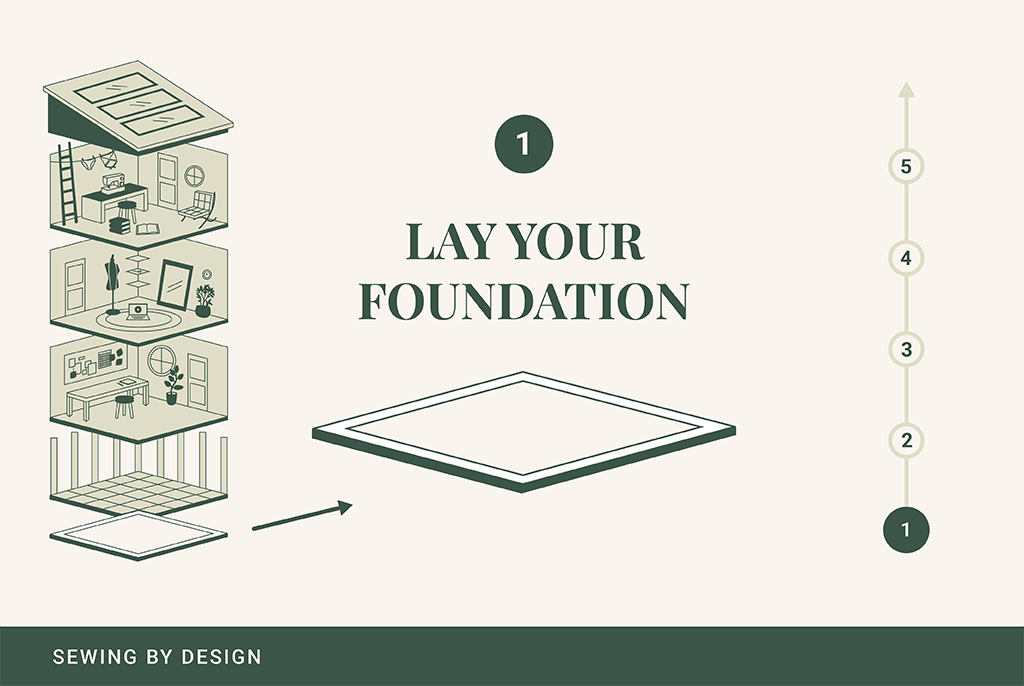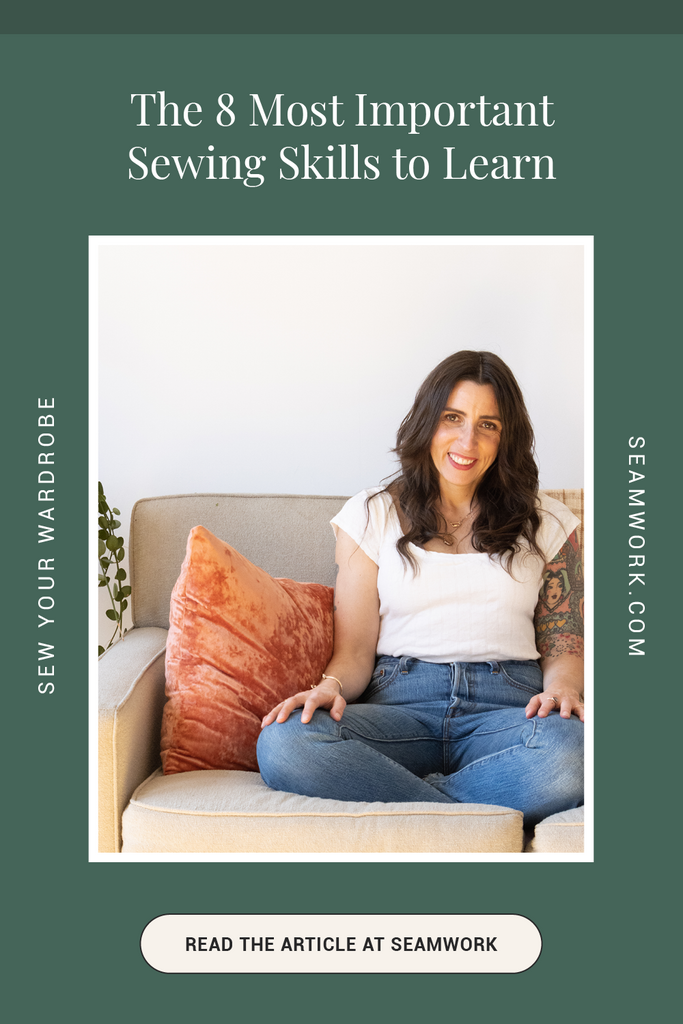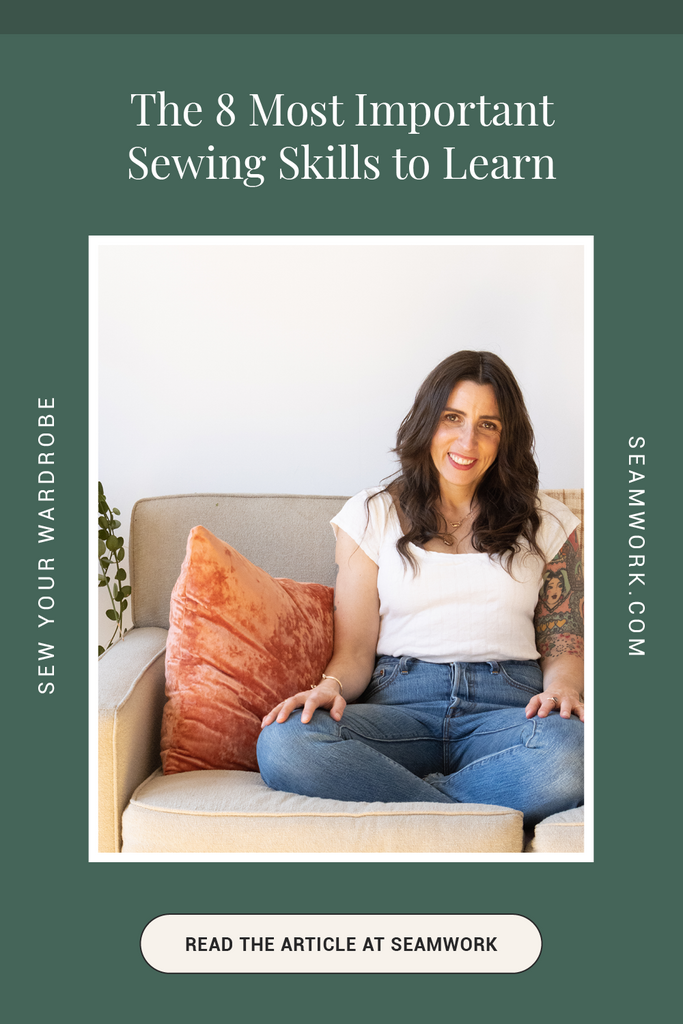Imagine that you are building a house on an empty piece of land.
You'd probably have big dreams about what this house would look like. You might be able to picture the lighting in each room, the sorts of cabinets you'd have in the kitchen, even the colors you'd paint the walls.
You might even have a Pinterest board (or several!) to help you envision exactly what that house would look like.
But first things first. You wouldn't start by buying paint and picking out cabinet hardware. You'd start building your house by creating a strong foundation.
It's the same with learning a complex skill like sewing. If we want to be able to make exactly what we want, we need to start with the right foundation.
As we take a holiday break to wrap up 2022, we’re re-airing a popular series from the Seamwork Radio podcast that originally aired earlier this summer. In the series, Sarai and Haley break down each step in the Sewing by Design framework.
If you missed the first article, you can read it here or listen to the podcast episode here. It introduces you to the Sewing by Design concept and explains why we compare sewing to a house.
The first step in this concept is to lay your foundation, just like you would when building your home.

The 80/20 Rule
If you open up a sewing book, you'll see a list of unfamiliar techniques, like how to bag a lining or bind your seams. You'll also find hundreds of new words. What even is a bodkin, and where is the bust apex? It's overwhelming. You signed up to sew clothes not learn a new language.
You can lessen this overwhelm by using something called the 80/20 skills.
What are the 80/20 skills? The idea comes from something called the Pareto Principle, but less formally, it's known as the "80/20 rule." It says that in many circumstances, 80% of the results come from 20% of the actions that you take.
In sewing, there is a core group of skills that you use over and over and over again, no matter what the project. They are the 20% of sewing skills that you use 80% of the time.
That's what we mean by the first step in our framework: Lay Your Foundation. Like creating a foundation for a house, you want to create a strong skillset right from the beginning.
8 Skills to Lay Your Foundation
1. Know Your Tools and Materials
You can’t really accomplish much without knowing your tools and materials, and this includes your machine and fabric. Learning about fabric is a lifelong part of learning how to sew, but you have to start somewhere.
Here are some resources to help you learn more about your tools and materials (including your machine).
-
The Ultimate Guide to Buying a Sewing Machine. - Seamwork’s Favorite Indie Notions
- Create a Sewing Toolkit
-
Do you have these 20 essential sewing tools? (Part 1) -
Do you have these 20 essential sewing tools? (Part 2) - Our Top 10 Favorite Fabrics and Where to Find Them
-
Want Strong Seams? Avoid sewing with these threads! - How to Buy Fabric Online: Know Your Terms | Weight and Drape
- Explore Sewing With Knits
- Browse the Seamwork Fabric & Textiles Archives
2. Read Your Map
Your sewing pattern is your map when you're learning to sew. But it's also full of unfamiliar jargon and tiny symbols that can be totally puzzling until you learn what they mean.
When you're sewing a commercial pattern, the pattern itself has all the answers. The person who's developed the pattern has sewn it countless times and knows the ins and outs of it. So learning how to read and also trust that information is super vital for successful projects.
Here is an article called The Anatomy of a Sewing Pattern to help you learn how to work with a sewing pattern.
3. Cutting and Marking
Here’s the cruel truth about sewing: you’ll spend much more time cutting, marking, and pressing fabric than sitting at your machine. This part of the process is slow, and you might not ever truly enjoy it. But here are some resources to help make it easier for you.
- How to Cut and Mark Fabric
-
The Best Way to Mark Fabric (We experimented with different fabric marking tools, so you don’t have to)
4. Sewing Seams
With your tools, map, and fabric-cutting skills in tow, the next foundational skill is sewing your seams. You’ll sew straight seams, corners, curved seams, and finishes, and you’ll learn how to press all of them. A lot of information is distilled into the humble seam.
It might not take long to learn how to sew a straight seam on your machine, but from there, the possibilities unfold. Here are some resources to help you explore seams.
- How to Sew a Basic Seam
- Essential Machine Stitches
- 5 Hand-sewing Stitches You Need to Know
- Do You Really Have to Staystitch?
- A Guide to Decorative Machine Stitching
- Topstitching Tricks
5. Adding Fullness
Why is adding fullness on the list of the most fundamental sewing skills to learn? It’s simple. You’re taking two-dimensional fabric and turning it into a three-dimensional garment. So think about the power of things like darts, gathers, tucks, and easing. These skills teach you to craft a three-dimensional thing that drapes, hugs, and moves with your body.
Here are some resources to help you explore fullness.
-
Sewing Darts (With video!) -
How to Sew Fisheye Darts (Also with video!) - How to Slash and Spread a Pattern
- Pattern Hack: Add Volume and Gathers to a Sleeve
- Create a Half-gathered skirt
- Draft a Gathered Skirt
-
How to Fit With Confidence: This class is free for Seamwork members, and it explains why adding volume and fullness is one of the most important concepts in fitting clothes to your body.
6. Installing a Sleeve
Here’s where sewing starts to feel real. When you first started sewing, did you assume that a sleeve cap would match the armscye on a pattern? What did you think when you found out the sleeve cap was bigger? And how were you supposed to sew something bigger onto something smaller?
When you install a sleeve, you use a bunch of the fundamental techniques you’ve learned so far, which is why it might feel intimidating. So here is a tutorial that shows you how to install a set-in sleeve step by step.
7. Adding Closures
This is another skill that you can continuously learn about. When you first start, you might work with elastic or casings. Then you might try zippers and bottons. From there, you can explore all the niche closures you’ll find in the notions aisle.
Here are some resources to help you explore closures.
- The Best Way to Sew a Button
- How to Sew an Invisible Zipper
- How to Sew a Centered Zipper
- How to Fix a Broken Zipper
- How to Sew a Triangular Bound Buttonhole
- Creating Roleau Button Loops
8. Finishing the Edges
Bias tape, facings, hems, and all kinds of neat seaming finishes give your garment a clean, professional look, even on the inside. You probably didn’t think much about finished edges when you first imagined sewing your own clothes, but these techniques make sewing so special, even if it’s just a little surprise that only you see when you get dressed.
Here are some resources for finishing your garments.
- How to Sew Flat Felled Seams
- How to Sew French Seams
- How to Sew a Hong Kong Finish
- How to Sew a Bias Tape Facing
- How to Sew an All-in-one Facing
- How to Sew an Exposed Facing
- Creating a Faced Split Hem
And there it is, your sewing foundation! Just like the foundation of your safe, sturdy home, these 8 skills support all the possibilities of your entire sewing practice.
What comes next? Design. Once you've laid your foundation, it's time to build your practice. We'll explore that in the next part of this series, next week.
Love the article? Pin it for later.


